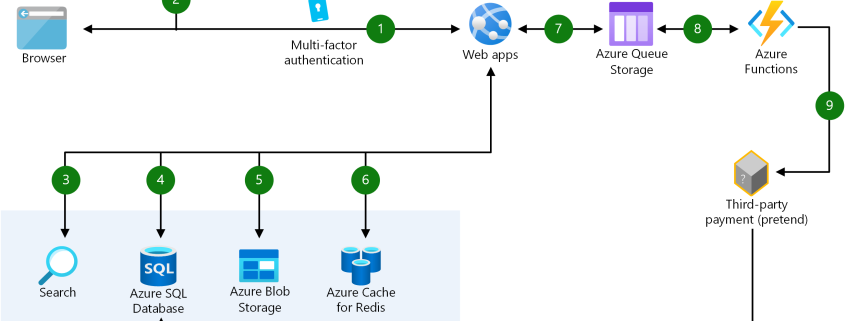Revolutionizing E-Commerce with Azure Functions: A Real-World Case Study
Azure Functions, Microsoft’s serverless computing platform, offers scalability, cost-effectiveness, and simplicity for event-driven programming. It allows developers to run small pieces of code, or “functions,” without worrying about the infrastructure. In this blog, we’ll discuss how Azure Functions were used to solve a critical challenge for an e-commerce client, enabling them to enhance their user experience and streamline operations.
Client Overview and Requirements
Our client, a fast-growing e-commerce platform, faced several challenges:
- Inventory Updates: The inventory system needed to sync in real-time with third-party warehouses to prevent overselling or stockouts.
- Order Notifications: Customers and vendors required instant notifications about order statuses (e.g., order placed, shipped, or delivered).
- Scalability: During flash sales and holiday seasons, traffic spiked significantly, requiring a solution that could handle high loads without compromising performance.
- Cost-Effectiveness: The client wanted a pay-as-you-go solution that avoided maintaining servers for occasional workloads.
Azure Functions emerged as the perfect solution for these requirements.
Solution: Implementing Azure Functions for E-Commerce
To address the client’s challenges, we designed and deployed multiple Azure Functions to handle event-driven workflows. These functions were part of a broader architecture, including Azure Event Grid, Azure Blob Storage, and Azure Cosmos DB, for seamless integration.
Key Use Cases of Azure Functions
1. Real-Time Inventory Synchronization
- Challenge: Inventory data from multiple third-party warehouses needed to be updated in real-time to avoid discrepancies.
- Solution:
- Azure Functions were triggered by changes in inventory data pushed by warehouses to an Azure Blob Storage container.
- The function processed the inventory file, validated data, and updated the central database (Azure Cosmos DB).
- It also sent notifications to the frontend API for instant updates to product availability on the website.
[FunctionName(“SyncInventory”)]
public static async Task<IActionResult> Run(
[BlobTrigger(“inventory/{name}”, Connection = “AzureWebJobsStorage”)] Stream myBlob,
string name,
ILogger log)
{
log.LogInformation($”Processing blob: {name}”);
// Parse inventory data
var inventoryData = await ParseInventoryFileAsync(myBlob);
// Update Cosmos DB
await UpdateInventoryInCosmosDB(inventoryData);
log.LogInformation(“Inventory synchronized successfully.”);
return new OkResult();
}
Outcome:
- Inventory updates occurred in under a second.
- Stockout incidents reduced by 80%.
- Improved customer satisfaction by providing accurate stock information.
2. Order Status Notifications
- Challenge: Customers wanted real-time updates on their orders, and vendors required notifications for fulfillment.
- Solution:
- Azure Functions were triggered by messages from an Azure Service Bus queue, where order events (e.g., “order placed,” “shipped”) were published.
- The function sent email and SMS notifications using SendGrid and Twilio APIs.
[FunctionName(“SendOrderNotification”)]
public static async Task Run(
[ServiceBusTrigger(“order-status”, Connection = “ServiceBusConnection”)] string orderEvent,
ILogger log)
{
log.LogInformation($”Received order event: {orderEvent}”);
var notification = GenerateNotification(orderEvent);
await SendNotificationAsync(notification);
log.LogInformation(“Notification sent successfully.”);
}
Outcome:
- Customers received real-time updates on their orders.
- Vendors experienced faster processing of orders due to instant notifications.
- Reduced customer support queries by 60%.
3. Flash Sale Scalability
- Challenge: During flash sales, the platform experienced traffic spikes of up to 10x the normal volume, requiring scalable backend processing.
- Solution:
- Azure Functions were integrated with Azure Event Grid to handle high-throughput order processing.
- Event Grid triggered Azure Functions to validate orders, process payments, and update inventory.
- Functions scaled automatically to handle thousands of orders per minute without downtime.
[FunctionName(“ProcessFlashSaleOrder”)]
public static async Task<IActionResult> Run(
[EventGridTrigger] EventGridEvent eventGridEvent,
ILogger log)
{
log.LogInformation($”Processing flash sale order: {eventGridEvent.Id}”);
var order = JsonConvert.DeserializeObject<Order>(eventGridEvent.Data.ToString());
await ProcessOrderAsync(order);
log.LogInformation(“Flash sale order processed successfully.”);
return new OkResult();
}
Outcome:
- Handled 500,000+ orders in a single day during a flash sale.
- Reduced infrastructure costs by 40% compared to using dedicated servers.
- Zero downtime or performance issues during peak traffic.
Implementation Process
1. Planning and Design
- Conducted workshops with the client to identify key events and workflows that could benefit from Azure Functions.
- Designed an architecture leveraging serverless technologies like Azure Event Grid and Service Bus.
2. Development and Testing
- Developed functions using C# and .NET Core.
- Tested functions with high volumes of simulated traffic to ensure scalability.
3. Deployment
- Deployed functions using Azure DevOps pipelines for CI/CD.
- Configured monitoring with Azure Application Insights to track performance and detect issues.
4. Monitoring and Optimization
- Used Azure Monitor and Application Insights to continuously optimize function performance.
- Implemented logging and alerting for proactive issue resolution.
Benefits Achieved
- Scalability: Azure Functions automatically scaled to handle high traffic during flash sales, eliminating downtime.
- Cost Savings: The client only paid for actual usage, saving 40% compared to traditional server-based solutions.
- Improved User Experience: Real-time notifications and accurate inventory updates enhanced customer satisfaction.
- Faster Time-to-Market: Serverless architecture allowed rapid development and deployment of new features.
- Simplified Maintenance: Azure Functions’ serverless nature reduced the need for infrastructure management.


Leave a Reply
Want to join the discussion?Feel free to contribute!